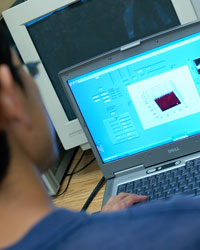General questions about UMBC:
 Q. Where is UMBC located?
Q. Where is UMBC located?
A. UMBC has a unique location and academic environment. It is situated on a spacious 480-acre campus only a few minutes from I-95, with easy access to Baltimore and Washington, DC. With about 14,000 students, UMBC combines the advantages of a research university with the intimate atmosphere of a liberal arts college. A recent College Guide issued by U.S. News and World Report ranked UMBC “among the major leagues of American higher education.” According to the Guide, institutions such as UMBC offer “more opportunities for obtaining the ingredients of a good education than do the majority of schools in other categories”. UMBC’s reputation as a first rate medium sized research university that cares for its undergraduates continues to grow every year.
Q. How large is UMBC?
A. UMBC has roughly 11,000 undergraduate and 3,000 graduate students. The University has 24 different PhD programs. UMBC has a reputation as a top mid‐sized research university that combines the advantages of a larger research university with the intimate atmosphere of a liberal arts college.
Q. Is UMBC a “good” university?
A. We are an R1! This means that UMBC is among the top ~150 universities in the US with the highest research activity.
The Department of Physics at UMBC:
Q. How large is the UMBC Physics Department?
A. The department is composed of 20 tenure-track faculty and three full-time teaching faculty and several research faculty. There are approximately 150 undergraduate physics majors, distributed over the four years. Twenty-seven percent of our majors and minors are female. In 2022, we awarded 19 BS degrees in physics; our average number of graduates over the past three years is 15-17. The department also has 50 graduate students in our Physics and Atmospheric Masters and PhD programs.
Q. Can I visit the campus before applying?
A. Absolutely! The Office of Undergraduate Admissions organizes a number of campus tours and admissions events. You can contact the Undergraduate Program Director if you are interested in visiting the department. You can meet professors, current students, tour some labs and visit a lecture.
Undergraduate students in the Department of Physics at UMBC.
Q. How large are physics classes at UMBC?
A. Physics majors can expect to have 10 – 25 students enrolled in the required physics courses. Introductory courses (PHYS 121 and 122) are large, but physics majors enroll in separate Honors sections that typically have no more than 25 – 35 students enrolled.
Q. Are graduate students used to teach undergraduate lecture courses?
A. No. Graduate teaching assistants run discussion sections in the introductory courses, assist in laboratory courses, grade student assignments, and provide help in the Physics Tutorial Center. Lecture courses are taught by full-time faculty in the department; in rare cases, an upper-level elective specialty course may be taught by a research professor or affiliated
faculty member.
Q. Is it possible to do undergraduate research in physics at UMBC?
A. Not only is it possible, but we strongly encourage it! Many students work on individual research projects, in collaboration with faculty members. This can be done as a special topics course for credit (PHYS450 or PHYS499), or as a paid research assistant or intern. The department has several summer internships available for undergraduates who want to do research over a summer, either at UMBC or at NASA Goddard Space Flight Center. The department also offers one student a year a Donald N.Langenberg Undergraduate Research Award to support undergraduate research.
Other Questions.
Q. Who do I contact if I have other questions?
A. For questions about the undergraduate programs, you can contact the Undergraduate Program Director. For general questions about the department, you can contact the Department Chair.